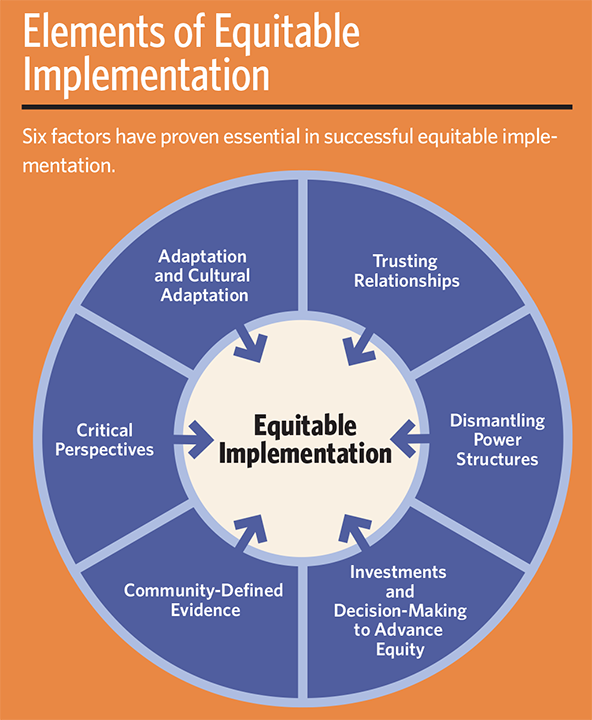 (Illustration by Maggie Chiang)
(Illustration by Maggie Chiang)
The field of implementation science needs to prioritize evidence-informed interventions that fit the daily lives of the communities in which they will be delivered. Early prevention and intervention efforts have the potential to achieve goals related to service access and outcomes, but without an explicit focus on equity, most fail to do so. Equitable implementation occurs when strong equity components—including explicit attention to the culture, history, values, assets, and needs of the community—are integrated into the principles, strategies, frameworks, and tools of implementation science. While implementation science includes many frameworks, theories, and models, a blueprint for equitable implementation does not yet exist.
Bringing Equity to Implementation

Implementation science—the study of the uptake, scale, and sustainability of social programs—has failed to advance strategies to address equity. This collection of articles reviews case studies and articulates lessons for incorporating the knowledge and leadership of marginalized communities into the policies and practices intended to serve them. Sponsored by the Anne E. Casey Foundation
-
Equity Is Fundamental to Implementation Science
-
Trust the People
-
Youth Leadership in Action
-
Community Takes the Wheel
-
Equity in Implementation Science Is Long Overdue
-
Listening to Black Parents
-
Faith-Based Organizations as Leaders of Implementation
-
Community-Defined Evidence as a Framework for Equitable Implementation
-
Community-Driven Health Solutions on Chicago’s South Side
-
Equitable Implementation at Work
This supplement addresses critical aspects of equitable implementation and attempts to define concrete strategies for advancing equity in implementation and in efforts to scale it. The core elements for equitable implementation include building trusting relationships, dismantling power structures, making investments and decisions that advance equity, developing community-defined evidence, making cultural adaptations, and reflecting critically about how current implementation science theories, models, and frameworks do (or do not) advance equity. Case examples described in this supplement demonstrate how specific activities across these core implementation elements can address cultural, systemic, and structural norms that have embedded specific barriers against Black, Indigenous, and other communities of color.

We wanted two types of articles for this supplement: case examples from the field of implementation science that explicitly focus on equity, and case examples from community-driven implementation efforts to inform implementation science in the future. We required that community members serve as co-authors with implementation scientists and funders. The range of perspectives and experiences shared in these articles provides us with an important vantage point for exploring equitable implementation. In response to questions about the process of writing for this supplement, several authors stressed the necessary challenge of balancing the different stakeholder perspectives and voices to write concise and compelling articles.
We attempt to summarize what we’ve learned about equitable implementation over the course of working on this supplement and in our own research. Here are 10 recommendations we have for putting equitable implementation into action.
Build Trusting Relationships
Implementation relies on collaborative learning, risk-taking, and openness to failure. At the center of this dynamic is vulnerability and trust. Trust engenders faith that partners can rely on each other to deliver on agreements and to understand—and even anticipate—each others’ interests and needs.1 A recommendation for building trusting relationships is:
1. Take the time to build trust through small, frequent interactions. Trust is not built through sweeping gestures, but through everyday interactions where people feel seen and heard. Trust requires long-term commitment, clear and comprehensive communication, and time. As described in the article about the partnership between ArchCity Defenders and Amplify Fund, implementation moves at the speed of trust, and that can take longer than we think. Funders need to provide the time and resources to build trust between themselves, other leaders, and community members and to support trust-building among stakeholders in the community.
Dismantle Power Structures
Power differentials exist in implementation efforts where specific individuals or groups have greater authority, agency, or influence over others. Implementation strategies should be chosen to address power differentials and position community members at the center of decision-making and implementation activities. Recommendations for dismantling power structures include:
2. Shed the solo leader model of implementation. Implementation science should promote collaborative leadership rather than rely on the charisma and energy of a single individual or organization. When leaders engage with community members and diverse stakeholder groups in meaningful activities that are ongoing, they develop a shared understanding of problems and potential solutions, develop strategies that address community needs and assets, and create a sense of mutual accountability for building the system of supports needed to sustain change and advance equitable outcomes.2
3. Distribute information and decision-making authority to those whose lives are most affected by the implementation. Empowering community members to make decisions about what is implemented and what strategies are used to carry out the work is critical for implementation to be relevant, successful, and sustainable. By recognizing the knowledge and experience that community stakeholders have and using that expertise to make decisions, public officials, funders, and practitioners create an environment of mutual comfort and respect. The central role that young people play in the development of Youth Thrive illustrates how an organization deliberately changed its work in order to ensure that nothing about young people was done without them having a collaborative role in shaping and delivering the curriculum.
Invest and Make Decisions to Advance Equity
Successful implementation is the product of dozens of shared decisions. In all implementation efforts, opportunities exist for critical decision-making that can either increase or decrease the likelihood that implementation will result in equitable outcomes. Recommendations include:
4. Engage in deliberate and transparent decision-making. Implementation decisions should be conscious, reflective, well thought through, and paced in a way that unintended consequences can be assessed. By taking the time to reflect, we can make course corrections for decisions that yield any unexpected results. Decision-making should also be transparently communicated with stakeholders at all levels of implementation.
5. Engage community members in interpreting and using data to support implementation. As described in this supplement, the success and sustainability of implementation are related to the alignment with and deep understanding of the needs of a community as defined by the community members themselves. The Children and Youth Cabinet in Rhode Island developed a resident advisory board and offered community members regular data review sessions. At these sessions, community members shared relevant context for findings and applied their experience to quality improvement.
Develop Community-Defined Evidence
Equitable implementation starts with how the evidence we seek to implement is developed. Research evidence often demonstrates different levels of effectiveness for different groups of people when replicated or scaled widely, leading to inequitable outcomes. As interventions are developed, it is critical to consider diversity in all its forms—including geographical, racial and ethnic, socioeconomic, cultural, and access—and to do this through the involvement of local communities. A recommendation for developing community-defined evidence is:
6. Co-design interventions with community members. This ensures interventions are relevant, desired by communities, and feasible to implement. Village of Wisdom created workshops by and for Black parents to share their parenting insights. These workshops became the foundation for developing culturally affirming instruction and for formulating tools and strategies that could create environments to encourage the intellectual curiosity and racial identity of Black children. By using the experiences and knowledge of Black parents to develop learning environments that nurture well-being, Village of Wisdom asserts the value of growing up Black and parenting Black children. To develop the Bienvenido Program, staff recruited leaders across the community as cocreators of a mental health needs assessment and the knowledge developed from it. The program was designed in response to Latinx residents’ experiences and the challenges they face in accessing mental health services. In both of these examples, community members’ experiences and perspectives were used to develop interventions that were aligned with community needs as they described them.
Make Adaptations
In order to reduce disparities in outcomes and advance equitable implementation, interventions and services must reach specific groups of people and demonstrate effectiveness in improving outcomes for them.3 Adaptations, especially cultural adaptations, must be made for both interventions and for implementation strategies to ensure the reach and relevance needed for equitable implementation. Recommendations for making adaptations include:
7. Seek locally based service delivery platforms. Implementation often relies on traditional institutions (e.g., hospitals) and systems of care (e.g., public health departments) that may limit or even impede access for specific groups of people. Two articles in this supplement discuss the importance of local, faith-based groups for supporting implementation—the parenting program in Travis County, Texas, and the cardiovascular health initiative in Chicago. Both case examples elevate the importance of adapting service delivery mechanisms to trusted community organizations to increase access for and uptake by local residents.
8. Address issues of social justice. Specific groups of people face significant stressors and barriers to care that are rooted in systemic and structural racism. Authors in this supplement emphasize the importance of adaptations that address issues related to these stressors. As noted in the article on culturally adapting a parenting intervention, parents may not be able to access and benefit from a parenting program if they are dealing with immigration policies and fear of deportation. In this case, adaptations to the program would need to include immigration counseling to support equitable implementation.
Critical Perspectives on Implementation Science
While implementation science is undergirded by theories, models, and frameworks, notably missing in the field are critical perspectives. The article on critical perspectives seeks to address this gap by discussing the methods used in implementation science and how they might perpetuate or exacerbate inequities. The authors also raise the importance of context and how it is addressed in implementation research and practice.
In the field of implementation science, context includes three levels: macro, organizational, and local.4 Macro context refers to socio-political and economic forces that either facilitate or hinder implementation efforts. Organizational context refers to organizational culture and climate that influence the behavior of staff. Local context refers to the community activities and relationships that influence implementation and behavior. Implementation strategies at the local or organizational level are limited in their impact on systemic and structural issues. In several articles of the supplement, authors advocate for doing more than describing the macro context. Implementation science needs to develop strategies that can address macro issues that foster or perpetuate disparities in outcomes. Recommendations include:
9. Develop implementation strategies that address the contextual factors that contribute to disparities in outcomes. Advocacy and policy implementation strategies focused on the macro context are more likely to advance equity than implementation strategies at organizational or local levels. Articles in this supplement describe the importance of building the capacity of community leaders to create advocacy networks for policies and funding that will help to sustain local programming. The example from ArchCity Defenders and Amplify Fund describes the critical role of funders in supporting changes to the social, political, and economic environments that grantees operate within to advance equity and promote sustainability. To cite another example, training community members to facilitate local programs and deliver interventions (as demonstrated in the Bienvenido Program and the cardiovascular health project in Chicago) ensures that implementation is tailored to the culture, history, and values of the local community; that interventions are delivered by trusted individuals; and that communities will be able to sustain the interventions.
10. Seek long-term outcomes that advance equity. The selection of interventions should include an assessment of the interventions’ likely influence on outcomes beyond near-term changes. Selecting programs that have the potential of a spillover effect in outcomes is a mechanism for equitable implementation. As described in a case example in this supplement, participants in the Bienvenido Program developed confidence and knowledge about participating in community meetings and engaging with locally elected officials and pursued careers in the mental health field. In the critical perspectives article, authors explained that some parenting programs demonstrate evidence for outcomes beyond strengthening parenting practices, such as reduction in substance abuse or increases in employment and stable housing.
The purpose of implementation science is to integrate research and practice in ways that will improve outcomes for people and communities. However, implementation frameworks, theories, and models have not explicitly focused on how implementation can and should advance equity. The recommendations that emerged across the diverse case examples in this supplement provide a starting point for changing and improving the methods and strategies used in implementation to ensure that equity is at the center of the work. As Ana A. Baumann and Pamela Denise Long argue in “Equity in Implementation Science Is Long Overdue,” implementation scientists must engage in critical reflection on the gaps between the intentions and the results of their work. We hope this supplement sparks reflection in funders, researchers, and practitioners involved in supporting implementation efforts with the hope of making people’s lives better and inspires their resolve and courage to shift toward learning from those who have the greatest stake in successful and equitable outcomes.
Support SSIR’s coverage of cross-sector solutions to global challenges.
Help us further the reach of innovative ideas. Donate today.
Read more stories by Audrey Loper, Allison Metz & Beadsie Woo.

